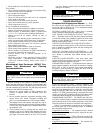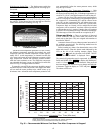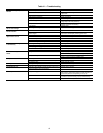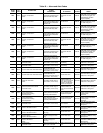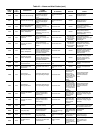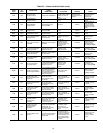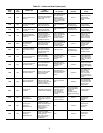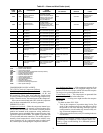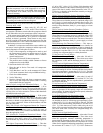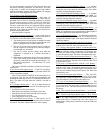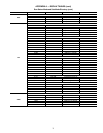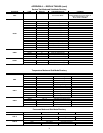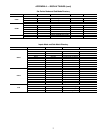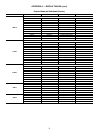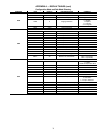
72
COMPRESSOR STUCK ON FAILURE ALARMS
Circuit A A051, A052
Circuit B A055, A056 — Alarm codes 051, 052, 055, and
056 are for compressors A1, A2, B1, and B2. These alarms oc-
cur when the CSB detects current when the compressor should
be off. When this occurs, the control turns off the compressor.
If the current sensor board reads ON while the compressor
relay has been commanded OFF for a period of 4 continuous
seconds, an alarm is generated. These alarms are only moni-
tored for a period of 10 seconds after the compressor relay has
been commanded OFF. This is done to facilitate a service tech-
nician forcing a relay to test a compressor.
In addition, if a compressor stuck failure occurs and the cur-
rent sensor board reports the compressor and the request off,
certain diagnostics will take place as follows:
1. If any of the compressors are diagnosed as stuck on and
the current sensor board is on and the request is off, the
control will command the condenser fans to maintain
normal head pressure.
2. The control will shut-off all other compressors.
The possible causes include welded contactor or frozen
compressor relay on the MBB.
To check out alarms A051-A056:
1. Place the unit in Service Test mode. All compressors
should be off.
2. Verify that there is not 24-v at the contactor coil. If there
is 24 v at the contactor, check relay on MBB and wiring.
3. Check for welded contactor.
4. Verify CSB wiring.
5. Return to Normal mode and observe compressor opera-
tion to verify that compressor current sensor is working
and condenser fans are energized.
A060 (Cooler Leaving Fluid Thermistor Failure)
— The
sensor reading is outside the range of –40 to 245 F (–40 to
118 C) then the alarm will occur. The cause of the alarm is usu-
ally a faulty thermistor, a shorted or open thermistor caused by
a wiring error, or a loose connection. Failure of this thermistor
will shut down the entire unit.
A061 (Cooler Entering Thermistor Failure)
— If the sensor
reading is outside the range of –40 to 240 F (–40 to116 C) then
the alarm will occur. The cause of the alarm is usually a faulty
thermistor, a shorted or open thermistor caused by a wiring er-
ror, or a loose connection. Failure of this thermistor will shut
down the entire unit.
T068, T69 (Circuit A,B Compressor Return Gas Tempera-
ture Thermistor Failure) — This alert occurs when the com-
pressor return gas temperature sensor is outside the range of
–40 to 240 F (–40 to 116 C). Failure of this thermistor will shut
down the appropriate circuit.
T073 (Outside Air Temperature Thermistor Failure)
— This
alert occurs when the outside air temperature sensor is outside
the range of –40 to 240 F (–40 to 116 C). Failure of this therm-
istor will disable any elements of the control which requires its
use.
T074 (Space Temperature Thermistor Failure)
— This alert
occurs when the space temperature sensor is outside the range
of –40 to 245 F (–40 to 118 C). Failure of this thermistor will
disable any elements of the control which requires its use. The
cause of the alert is usually a faulty thermistor in the T55, or
T58 device, a shorted or open thermistor caused by a wiring er-
ror, or a loose connection.
T090 (Circuit A Discharge Pressure Transducer Failure)
T091 (Circuit B Discharge Pressure Transducer Failure) —
Alert codes 090 and 091 are for circuits A and B respectively.
These alerts occur when the pressure is outside the range of 0.0
to 667.0 psig. A circuit cannot run when this alert is active. Use
the scrolling marquee to reset the alert. The cause of the alert is
usually a faulty transducer, faulty 5-v power supply, or a loose
connection.
T092 (Circuit A Suction Pressure Transducer Failure)
T093 (Circuit B Suction Pressure Transducer Failure) —
Alert codes 092 and 093 are for circuits A and B respectively.
These alerts occur when the pressure is outside the range of 0.0
to 420.0 psig. A circuit cannot run when this alert is active. Use
the scrolling marquee to reset the alert. The cause of the alert is
usually a faulty transducer, faulty 5-v power supply, or a loose
connection.
T094 (Discharge Gas Thermistor Failure)
— This alert oc-
curs for units which have the digital compressor installed on
circuit A. If discharge gas temperature is open or shorted, the
circuit will be shutoff. The alert will reset itself when discharge
temperature is less than 250 F (121.1 C). The cause of the alert
is usually low refrigerant charge or a faulty thermistor.
T110 (Circuit A Loss of Charge)
T111 (Circuit B Loss of Charge) — Alert codes 110 and 111
are for circuits A and B respectively. These alerts occur when
the compressor is OFF and the discharge pressure is less than
26 psig.
T112 (Circuit A High Saturated Suction Temperature)
T113 (Circuit B High Saturated Suction Temperature) —
Alert codes 112 and 113 occur when compressors in a circuit
have been running for at least 5 minutes and the circuit saturat-
ed suction temperature is greater than 70 F (21.1 C). The high
saturated suction alert is generated and the circuit is shut down.
T114 (Circuit A Low Superheat)
T115 (Circuit B Low Superheat) — Alert codes 114 and 115
occur when the superheat of a circuit is less than 5 F (2.8 C) for
5 continuous minutes. The low superheat alert is generated and
the circuit is shut down.
T116 (Circuit A Low Cooler Suction Temperature)
T117 (Circuit B Low Cooler Suction Temperature) — Alert
codes 116 and 117 are for circuits A and B respectively. These
alerts are generated if the capacity stages are reduced three
times without a 30 minute interval between capacity reductions
due to operating mode 7 or mode 8.
T118 (High Discharge Gas Temperature Alert)
A118 (High Discharge Gas Temperature Alarm) — This
alert or alarm occurs for units which have the digital compres-
sor installed on circuit A. If discharge gas temperature is great-
er than 268 F (131.1 C), the circuit will be shut off. The alert
will reset itself when discharge temperature is less than 250 F
(121.1 C). If this alert occurs 3 times within a day, the A118
alarm will be generated and the alarm must be reset manually.
The cause of the alert is usually low refrigerant charge or a
faulty thermistor.
T126 (Circuit A High Head Pressure)
T127 (Circuit B High Head Pressure) — Alert codes 126 and
127 are for circuits A and B respectively. These alerts occur
when the appropriate saturated condensing temperature is
greater than the operating envelope shown in Fig 14. Prior to
the alert, the control will shut down one compressor on a circuit
if that circuit's saturated condensing temperature is greater than
the maximum SCT minus 5° F (2.7° C). If SCT continues to
IMPORTANT: If the CS is always detecting current, verify
that the compressor is on. If the compressor is on, check
the contactor and the relay on the MBB. If the compressor
is off and there is no current, verify the CSB wiring and
replace if necessary.
IMPORTANT: Return to Normal mode and observe com-
pressor operation to verify that compressor current sensor
is working and condenser fans are energized.



